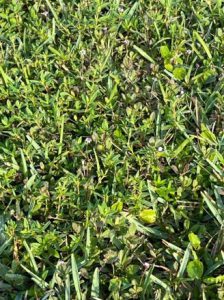A lawn by any other name…
The “lawn” is a cult phenomenon in the United States. Somewhere along the line, we associated a monoculture of a single grass species with the ultimate achievement in landscaping. Unfortunately, this mindset has become entrenched in the collective psyche. Even when it has become impractical and unsustainable, many refuse to give up on it.
What if we take the good in a lawn and toss out the parts that contribute to waste? What if it’s time to consider Mixed Mowable Species Lawns? Most people in South Florida who have St. Augustine lawns are constantly fighting with disease, weeds, watering, and the high cost of maintenance. Add to this the fact that Lethal Viral Necrosis is becoming more prevalent, for which there is no cure.
If you look closely at your turf areas, you may notice that the so-called weeds fill in the gaps where the turfgrasses are thin, weak, diseased or dying. Perhaps it’s too shady, too wet/dry, compacted or nutrient deficient? Turfgrasses often struggle with such issues, but these low-growing, mostly native plants seem to survive.
Consider using more Mixed Mowable Species
Benefits include:
- Mixtures increase the overall turf quality under drought
- Flowers increase aesthetics, attract and support pollinators, like butterflies.
- Legumes fix atmospheric nitrogen in the soil
- Increases carbon sequestration
- Decreases non-point source pollution due to less or no fertilizer
- Performs better in problem areas
- Saves time and money, with less or no pesticides required
- Conserves water
- Adds species diversity
- Provides habitat for beneficial insects

In this photo there are at least 10 MMS – Mixed Mowable Species:
Desmodium, Mexican clover, Matchweed, Purslane, Dayflower, Goosegrass, Spermacoce, Dollarweed, Stylosanthes, and of course, St. Augustine. Kept mowed, it will behave just like any monoculture turf.
Some mixed mowable species to consider growing with turf:
Creeping Beggarweed – Desmodium spp.
Southern Pencil-flower –Stylosanthes
Mexican clover, Pusley – Richardia spp.
Frog Fruit, Matchweed – Phyla nodiflora
Crabgrass – Digitaria spp.
Sedges – Cyperus spp.
Spurges – Euphorbia spp. (Chamaesyce)
Sorrel – Oxalis spp.
Dayflower – Commelina diffusa
Purslane – Portulaca oleracea
Mimosa – Mimosa strigillosa
Blue Eyed Grass – Sisyrinchium angustifolium

Consider incorporating weeds as part of your turf.
Instead of trying to win every turf war, see if there are places where a MMS can be tolerated, encouraged and appreciated.
Sometimes a mixed mowable species can be the best kind of “turf”.
This would include the “weeds” that are ubiquitous and persistent, which also makes them resilient and low maintenance. As an added benefit, MMS lawns require few to no pesticides, so are safer for pets and children who play on them frequently.
It’s time….be the change.
An Ecological Perspective on Common Lawn “Weeds” (ufl.edu)
Florida Wildflower Lawns – UF/IFAS Extension Orange County (ufl.edu
Flowering Groundcovers: Beyond Just Grass – UF/IFAS Extension Marion County (ufl.edu)
Source: UF/IFAS Pest Alert
Note: All images and contents are the property of UF/IFAS.



